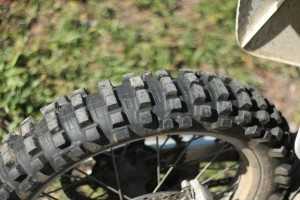Rider Fitness: Arm Pump Prevention and Treatment
There’s nothing worse than the onset of arm pump during the final laps of a race or long ride. Your arms feel like a ton of bricks. You can’t maintain a good grip on your bike. And you practically lose all feeling from the elbow down. By the end of the ride, your arms are completely useless, and all you can do is wait for the pain and numbness to go away.
 The symptoms above contribute to the ever-increasing statistic of wrecks, crashes, and low-position finishes caused by arm pump. Even today, there is no set cure for it. But there are ways you can significantly decrease the degree of the effects it has on your body. Here, I’ll show you a few of the most effective means of how to eliminate arm pump as part of your rider fitness program.
The symptoms above contribute to the ever-increasing statistic of wrecks, crashes, and low-position finishes caused by arm pump. Even today, there is no set cure for it. But there are ways you can significantly decrease the degree of the effects it has on your body. Here, I’ll show you a few of the most effective means of how to eliminate arm pump as part of your rider fitness program.
What Causes Arm Pump?
To know how to properly combat arm pump, it’s essential to have a basic understanding of why it occurs.
Arm pump occurs as the result of a build-up of “old” blood in your forearm. Your forearms are continually receiving new blood, but when they’re under intense stress (i.e., a rigorous ride), they’re not very efficient at removing old blood. So when the new blood enters, it creates a build-up of pressure in the forearm. As a result, the muscles, veins, and nerves will constrict and restrict blood flow, thus hindering your forearms’ ability to function correctly.
 So the key to preventing arm pump is to condition your body to be more efficient at removing old blood, so there’s more room for new, oxygen-rich blood. The best way to make your body more efficient at old blood removal is through cardiovascular fitness conditioning.
So the key to preventing arm pump is to condition your body to be more efficient at removing old blood, so there’s more room for new, oxygen-rich blood. The best way to make your body more efficient at old blood removal is through cardiovascular fitness conditioning.
When you’re in better cardiovascular shape, your body removes more old blood, delivers it to the lungs for oxygen replenishment, and sends it back out for delivery as “new” blood.
How To Condition Your Body To Resist Arm Pump
Many riders tend to focus on arm isolation exercises as a way to fend off arm pump. In their minds, the arm pump issue is related solely to strength. But we now know it’s more cardiovascular-related than anything else. Therefore, physical conditioning is the most effective rider fitness strategy currently available.
Below, you’ll find a selection of the most effective tips and strategies for battling arm pump and resisting the negative effects it has on your body during a race or event.
Everyday Prevention Methods
Ride as much as possible. This is single-handedly the best way to build up resistance to arm pump. Regular riding will naturally strengthen and condition your forearms. But the key is to ride regularly – at least four to five times per week.
Total body exercises. Unfortunately, many riders (myself included) can’t ride every day. If that’s the case, then a cardiovascular-focused workout is the next best option. A workout program that includes a cardio session (i.e., running, jogging, rowing, etc.) and a strength training session are the most effective arm pump exercises. But remember not to focus on isolation exercises. Instead, incorporate a total body workout regimen with compound exercises (i.e., push-ups, pull-ups, deadlifts, etc.).
Grip with your knees. Learn to grip your bike more with your knees. This tactic allows you to loosen your grip on your handlebars while still maintaining control of the bike. Knee gripping helps your forearms relax more, which promotes better blood flow.
Race/Ride Day-Specific Prevention Methods

Always warm-up. Approximately 30-45 minutes before a race or event do a thorough 20-minute warm-up session. Warming up increases your heart rate and gets your blood flowing throughout your entire body.
Stay hydrated. Proper hydration is crucial to preventing not just arm pump, but also cramps and muscle fatigue in other major muscle groups. Drink between 2-3 cups of water approximately an hour before the race. Then drink one cup every 15 minutes during the race (using a camel pack, unless you’re wicked fast at pit stops).
Even after utilizing all of the prevention methods above, there’s still a possibility that arm pump will happen during a race. But you’ll find that the amount of grip pain, fatigue, and numbness will be far less severe than usual. Follow the preventative measures above as part of your rider fitness program against arm pump, and you’ll get positive results on the track and trail!
If you have any questions or anything to add, please leave them in the comments or on our FaceBook page!




